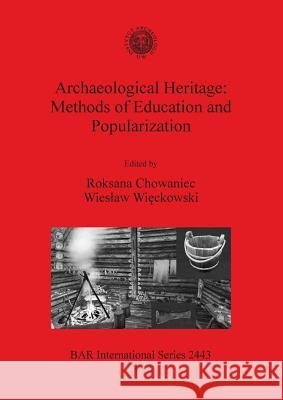Archaeological Heritage: Methods of Education and Popularization » książka
Archaeological Heritage: Methods of Education and Popularization
ISBN-13: 9781407310473 / Angielski / Miękka / 2012 / 179 str.
This volume stems from an International Conference titled 'Methods of Education and Popularization in Archaeological Heritage', held in December 1-3, 2011, at the University of Warsaw, Institute of Archaeology, Poland, organized by Foundation of Friends of the Institute of Archaeology. Contents:1) Painted tombs from Viminacium and their presentation to the public (Jelena Andelkovic); 2) Amateurs and archaeology. Experimental method or madness? How do we share it all? (Spyridon Bakas); 3) Goths' Village in Maslomecz(Bartlomiej Bartecki); 4) Using virtual museums in education: tools for spreading Calabrian cultural heritage among today's youth (Francesca Bertacchini, Assunta Tavernise); 5) Communicating archaeology outside of museum walls. Spica and Congress square - case study from Slovenia (Dijana Cerovski, Irena Sinkovec); 6) Archaeology on the Web. Educating children and youth though internet portals (Roksana Chowaniec); 7) Fostering education through virtual worlds: the learning and dissemination of ancient Biskupin (Roksana Chowaniec, Assunta Tavernise); 8) Discovering archaeology by residents of a small town, or on the promotion of archaeology in Mosina near Poznań (Anna Cicha, Joanna Struwe); 9) Using social media and new technologies in the popularization and promotion of archaeology (Karolina Ciejka); 10) The 'SiciliAntica' Association and its activities in archaeology education and popularization (Marta Fitula); 11) The Viminacium Archaeological Park and Scientific and Research Centre (Snezana Golubovic, Milica Tapavicki-Ilic); 12) Museum education. Exhibitions and outdoor events as forms of integrated presentation and popularisation of archaeological heritage in Biskupin (Anna Grossman, Pawel Hildebrandt); 13) Multifarious transmission of museum lessons in Biskupin in education and popularizing of archaeological heritage (Anna Grossman, Malgorzata Starak-Juchniewicz, Pawel Hildebrant); 14) Educational activities, workshops, events or how an archaeological museum can present the past (Sabina Hryniewiecka, Marta Kalisz); 15) Who's to blame for the tabloidization of archaeology or how to sell science cheap in the Polish press (Katarzyna Jarosz); 16) Educational activities of the 'Blue Lion' archaeological education center, present and future (Monika Jodczyk); 17) Reflections on popularising Egyptology (Agnieszka Kowalska, Kamil Kuraszkiewicz); 18) Servizio Soprintendenza ai beni culturali ed ambientali - Siracusa. Education and activities in the promotion of archaeological heritage: selected examples (Rosa Lanteri); 19) Archery Tournament in Biskupin as an example of polygenic forms of implementing the promotion of archaeological heritage (Marek Lewandowski, Piotr Dmochowski); 20) Roman cultural heritage as a tourist and educational resource (Nemanja Mrdic); 21) Educational activities at the Archaeological Museum of the Middle Oder Region (Julia Orlicka-Jasnoch); 22) The archaeological fEte in ludic space (Michal Pawleta); 23) Archaeological workshops to celebrate Children's Day (Joanna Popielska-Grzybowska); 24) Per aspera ad astra... Children at the University (Monika Rekowska); 25) Virtual reconstruction as an archaeological didactic tool (Karolina Rosinska-Balik); 26) Archaeology as a tool for rehabilitation of people with special needs (and vice versa) (Dario Scarpati); 27) Education, not only archaeological, in the Museum of Archaeology and History in Elblag: should we be ashamed? (Grzegorz Stasielowicz); 28) Industriae Theatrum Ex Silesia: Showing the functioning of a medieval industry in a contemporary industrial conurbation (Joanna Tokaj, Dariusz Rozmus, Magdalena Cyankiewicz); 29) Heritage for the People. Archaeology at the City Museum of Ljubljana and Visitors to the Museum (Bernarda Zupanek, Tamara Bregar)
This volume stems from an International Conference titled 'Methods of Education and Popularization in Archaeological Heritage', held in December 1-3, 2011, at the University of Warsaw, Institute of Archaeology, Poland, organized by Foundation of Friends of the Institute of Archaeology.











